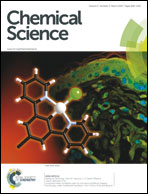Pauling's third rule beyond the bulk: chemical bonding at quartz-type GeO2 surfaces†
Abstract
Germanium dioxide (GeO2) finds increasing application on the nanoscale, which calls for a detailed understanding of its crystal surfaces. In particular, the metastable α-quartz-type polymorph of GeO2 exhibits many desirable properties but also a non-trivial structural chemistry. Here, we contribute a surface study of quartz-type GeO2 in which we combine periodic density-functional theory (DFT) with classical chemical reasoning. We report on the most relevant surfaces, both freshly cleaved and structurally optimised. Stability trends of the latter are discussed in terms of the central structural unit—the [GeO4] tetrahedra—and how they are linked at the surface, in seamless extension of Pauling's third rule which had originally been conceived for bulk crystal structures. A more detailed, energy-resolved view is afforded by computing crystal orbital overlap populations (COOP) with a novel projection scheme; this way, a “bond strength” is directly gauged from plane-wave DFT output, and it allows the different surface stabilities to be rationalised in terms of “strengthened” and “weakened” bonds. These results and ways of thinking may be relevant for future studies on nanocrystalline GeO2 and, in a broader context, also for silica (SiO2) and other surfaces.


 Please wait while we load your content...
Please wait while we load your content...